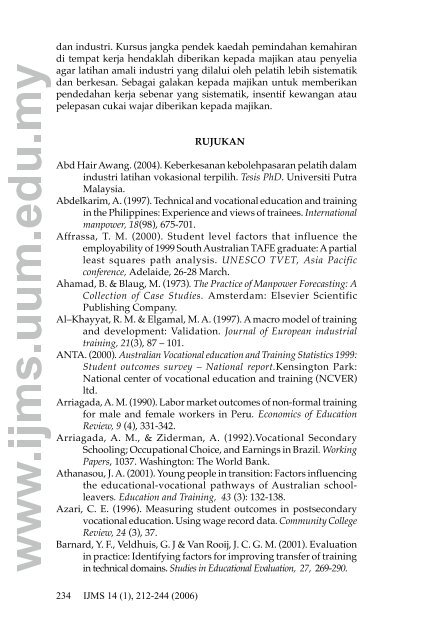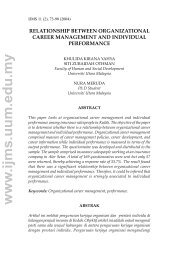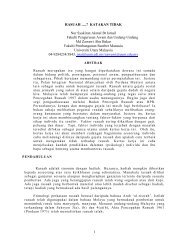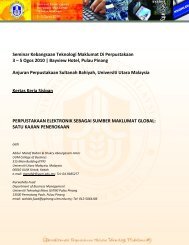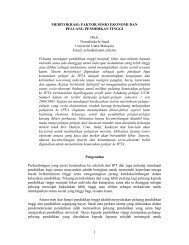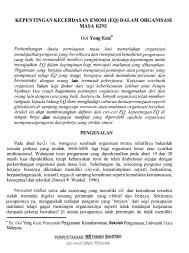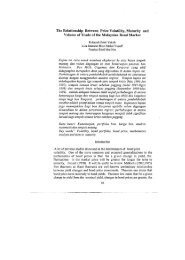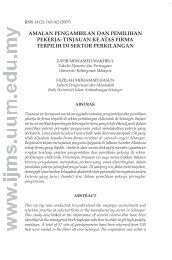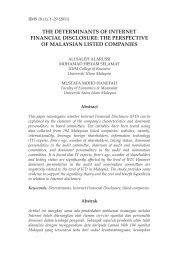PROGRAM LATIHAN KEMAHIRAN: PERBANDINGAN KOS ...
PROGRAM LATIHAN KEMAHIRAN: PERBANDINGAN KOS ...
PROGRAM LATIHAN KEMAHIRAN: PERBANDINGAN KOS ...
You also want an ePaper? Increase the reach of your titles
YUMPU automatically turns print PDFs into web optimized ePapers that Google loves.
www.ijms.uum.edu.my<br />
dan industri. Kursus jangka pendek kaedah pemindahan kemahiran<br />
di tempat kerja hendaklah diberikan kepada majikan atau penyelia<br />
agar latihan amali industri yang dilalui oleh pelatih lebih sistematik<br />
dan berkesan. Sebagai galakan kepada majikan untuk memberikan<br />
pendedahan kerja sebenar yang sistematik, insentif kewangan atau<br />
pelepasan cukai wajar diberikan kepada majikan.<br />
234 IJMS 14 (1), 212-244 (2006)<br />
RUJUKAN<br />
Abd Hair Awang. (2004). Keberkesanan kebolehpasaran pelatih dalam<br />
industri latihan vokasional terpilih. Tesis PhD. Universiti Putra<br />
Malaysia.<br />
Abdelkarim, A. (1997). Technical and vocational education and training<br />
in the Philippines: Experience and views of trainees. International<br />
manpower, 18(98), 675-701.<br />
Affrassa, T. M. (2000). Student level factors that influence the<br />
employability of 1999 South Australian TAFE graduate: A partial<br />
least squares path analysis. UNESCO TVET, Asia Pacific<br />
conference, Adelaide, 26-28 March.<br />
Ahamad, B. & Blaug, M. (1973). The Practice of Manpower Forecasting: A<br />
Collection of Case Studies. Amsterdam: Elsevier Scientific<br />
Publishing Company.<br />
Al–Khayyat, R. M. & Elgamal, M. A. (1997). A macro model of training<br />
and development: Validation. Journal of European industrial<br />
training, 21(3), 87 – 101.<br />
ANTA. (2000). Australian Vocational education and Training Statistics 1999:<br />
Student outcomes survey – National report.Kensington Park:<br />
National center of vocational education and training (NCVER)<br />
ltd.<br />
Arriagada, A. M. (1990). Labor market outcomes of non-formal training<br />
for male and female workers in Peru. Economics of Education<br />
Review, 9 (4), 331-342.<br />
Arriagada, A. M., & Ziderman, A. (1992).Vocational Secondary<br />
Schooling; Occupational Choice, and Earnings in Brazil. Working<br />
Papers, 1037. Washington: The World Bank.<br />
Athanasou, J. A. (2001). Young people in transition: Factors influencing<br />
the educational-vocational pathways of Australian schoolleavers.<br />
Education and Training, 43 (3): 132-138.<br />
Azari, C. E. (1996). Measuring student outcomes in postsecondary<br />
vocational education. Using wage record data. Community College<br />
Review, 24 (3), 37.<br />
Barnard, Y. F., Veldhuis, G. J & Van Rooij, J. C. G. M. (2001). Evaluation<br />
in practice: Identifying factors for improving transfer of training<br />
in technical domains. Studies in Educational Evaluation, 27, 269-290.


